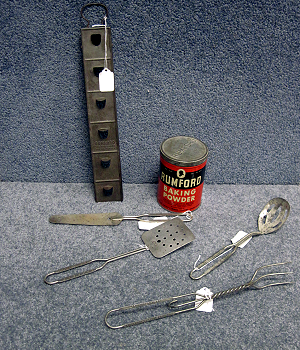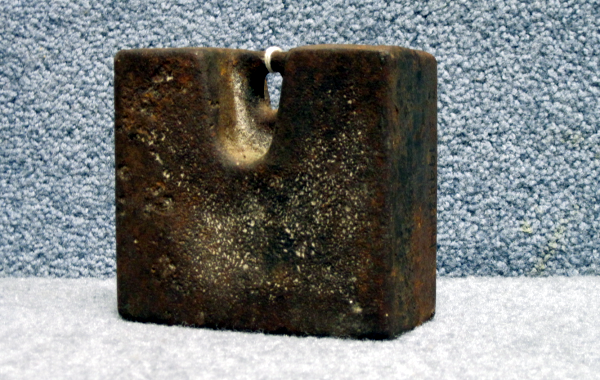The ‘Smithsonian’ Event
For our ‘Smithsonian’ event we were able to meet at the Weaver Memorial Library. Joyce May, the adult services coordinator at the library, gave a short introduction and then our president, Nancy Moore, took over as Mistress-of-Ceremony for the event. The name for the event was chosen because the Historial Society preserves the history of East Providence in similar fashion as the Smithsonian preserves our American history.
A week before the event we had brought several artifacts from the museum to display in the library’s showcase, hoping this would pique the interest of library patrons to come to find out more about the items. Apparently it worked; Joyce had to add chairs to accommodate all the visitors.
Several members of the Historical Society’s board had volunteered to speak about the items now on display on a table in front of the audience. The Crescent Park glass items were introduced by Edna Anness. Many visitors to the amusement park bought the flashed ruby glass souvenirs to remember the good times they had there; our items had 1903 and 1904 etched into them.
Edna also educated us about Captain Hudson’s sword and some examples of the china from the Hunt family. One of the items from the set was a large serving platter. The pattern is Mulberry and dates from 1840. The sword dates back to the Civil War and was carried into battle by the Captain. He made his home right here in East Providence on Water Street.
Dot Thornley had prepared a special display with photos of the gardens around the Hunt House. She talked about the group of volunteers enjoying each other’s company while maintaining the gardens. As a special incentive the group ends most of their gardening gatherings with a potluck meal. The gardens are also part of URI’s Master gardeners program.
You cannot talk about the history of East Providence without mentioning the Rumford Chemical Company. Our museum has an extensive collection of Rumford Company artifacts and we had several on display. It was Edna again who showed the items and explained the use of the more obscure ones like the potato baker. The items that were on display could be obtained for free from the company by redeeming coupons from Rumford baking powder. The utensils were produced at the factory and had the company’s name embossed on it.
Besides serving as the MC for the evening, Nancy Moore introduced the audience to her favorite museum item: a doll and carriage. Both items were playthings of Dorothy Marshall and Nancy had fallen in love with the doll at the museum. In her research she learned that the doll was an Effanbee “Bubbles” doll from 1928 that could suck her left index finger rather than the more common thumb. She also was supposed to “walk, talk and sleep”. The carriage she sits in is a Heywood-Wakefield wicker carriage from the same period. The doll and carriage must have been a girl’s dream-come-true at that time. But the real connection to the past came when a gentleman from the audience mentioned that Dorothy had him hold the doll many times years ago. It turns out that our member George Amaral had been Dorothy’s neighbor and the two spent many happy hours playing together.
We also had a model of Union Primary on display. The model was built in the late 1980’s by Eliot Plummer when the fate of the building was very uncertain. Dave Kelleher used the model to entertain and inform us about his time as the principal there. To liven his talk he also brought along some photos from his time there. Dave had the dubious honor to be the principal who had to close down the school after it had served Rumford for so many years.
Oh, yes, the ‘mystery item’ . . . Reinhard Wohlgemuth explained, after soliciting some guesses from the audience, that it was a horse weight. Or better, a horse tethering weight. It was made by Joe Butterworth in his blacksmith shop once located at the corner of Pawtucket and Taunton Avenue where Gregg’s Restaurant is today. You would keep it on the carriage or delivery wagon and use it to tie up the horse if no hitching pole was available. A rope was attached to it and you would tie the reigns to it after you dropped the weight on the ground near the front of the horse.
Last, but certainly not least, there was an old uniform coat on display. It was given to the museum by Rosemarie Sirenski, and she also was the one who spoke about it. She has spent much time researching the coat, but so far there are many unanswered questions about it. It appears to date back to the Civil War, although the uniform colors generally were blue or grey. We did learn though that some volunteers from fire departments were allowed to wear red coats and that would be a possible answer. Even the buttons did not allow a positive identification of the coat and Rosemarie continues her research.
It was a very entertaining and educational evening for everybody involved. If some of these artifacts from East Providence’s past were of interest to you I invite you to visit the Hunt House Museum to learn more. The items on display for this special evening were only a small part of what you can see at the museum.
All photos courtesy of Dot Thornley.






